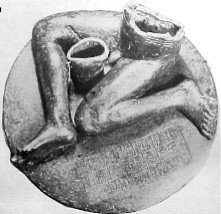Facts About Bassetki Statue
The Bassetki Statue is a compelling artifact from the Akkadian period of ancient Mesopotamia. Discovered in 1974 during military operations in the village of Bassetki, this statue originally adorned the doorway of a palace belonging to the Akkadian ruler Naram-Sin. Crafted entirely from copper, it depicts a seated nude human figure on a round pedestal, although only the lower portion of the statue remains intact.
Amidst the chaos of the 2003 invasion of Iraq, the Bassetki Statue became one of many artifacts looted from the Iraq Museum. The thieves handled it recklessly, evidenced by the cracks left in the museum floor from being dropped multiple times. Labeled as one of the most-wanted stolen antiquities, the statue was ultimately recovered thanks to the information provided by three individuals. It had been coated in grease and hidden in a cesspool. Upon its recovery, the statue was restored to its place in the Iraq Museum, displayed alongside other reclaimed treasures.
The statue bears a cuneiform inscription in Old Akkadian, detailing Naram-Sin's ascent to godhood in the city of Akkad following his suppression of a revolt. Created using the lost-wax casting process, the statue features a seated male figure with remarkably naturalistic detail, signifying a notable departure from the earlier artistic styles of the Akkadian period.

 Turkey
Turkey